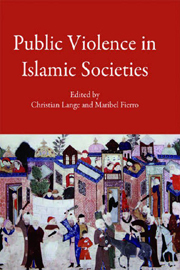 Public Violence in Islamic Societies
Public Violence in Islamic Societies Book contents
- Frontmatter
- Contents
- List of abbreviations
- Acknowledgements
- Introduction: Spatial, ritual and representational aspects of public violence in Islamic societies (7th–19th centuries ce)
- PART I Public violence and the construction of the public sphere
- PART II Ritual dimensions of violence
- PART III Representations of public violence
- 9 Responses to crucifixion in the Islamic world (1st–7th/7th–13th centuries)
- 10 Violence and the prince: the case of the Aghlabid Amīr Ibrāhīm II (261–89/875–902)
- 11 Concepts of justice and the catalogue of punishments under the Sultans of Delhi (7th–8th/13th–14th centuries)
- 12 Public violence, state legitimacy: the Iqāmat al-ḥudūd and the sacred state
- 13 Violence in Islamic societies through the eyes of non-Muslim travellers: Morocco in the 19th and early 20th centuries
- Index
13 - Violence in Islamic societies through the eyes of non-Muslim travellers: Morocco in the 19th and early 20th centuries
from PART III - Representations of public violence
Published online by Cambridge University Press: 12 September 2012
- Frontmatter
- Contents
- List of abbreviations
- Acknowledgements
- Introduction: Spatial, ritual and representational aspects of public violence in Islamic societies (7th–19th centuries ce)
- PART I Public violence and the construction of the public sphere
- PART II Ritual dimensions of violence
- PART III Representations of public violence
- 9 Responses to crucifixion in the Islamic world (1st–7th/7th–13th centuries)
- 10 Violence and the prince: the case of the Aghlabid Amīr Ibrāhīm II (261–89/875–902)
- 11 Concepts of justice and the catalogue of punishments under the Sultans of Delhi (7th–8th/13th–14th centuries)
- 12 Public violence, state legitimacy: the Iqāmat al-ḥudūd and the sacred state
- 13 Violence in Islamic societies through the eyes of non-Muslim travellers: Morocco in the 19th and early 20th centuries
- Index
Summary
The travellers
The purpose of this chapter is to examine the work of Spanish travellers to Morocco during the 19th and early 20th centuries and to analyse their views on the “public display of violence”. Thus it will deal with materials generated outside Muslim societies, and with a period of history marked by the European threat towards Morocco, which finally lost its independence at the beginning of the 20th century and became a “protectorate” of France and Spain in 1912.
Travel accounts are never objective, although many travellers pretend eagerly to be exact in their descriptions and fair in their opinions. The Spanish travellers examined here are no exception to this rule, and their views on Morocco and the Moroccan ways of life are heavily influenced by the circumstances of their time and by their personal attitudes. As will be shown later, their descriptions of public violence derive, consciously or unconsciously, from a frame of mind they all share: violence is at the core of Moroccan society, inasmuch as it is a Muslim society. Public display of violence is practised in Morocco in a ruthless and chaotic way, in open contrast to the organized control of violence found in Western societies. This and other similar arguments were frequently used during the 19th century to justify Spanish intervention in Moroccan politics and by those who called for colonial action, military or not, against this country.
- Type
- Chapter
- Information
- Public Violence in Islamic SocietiesPower, Discipline, and the Construction of the Public Sphere, 7th-19th Centuries CE, pp. 276 - 291Publisher: Edinburgh University PressPrint publication year: 2009


